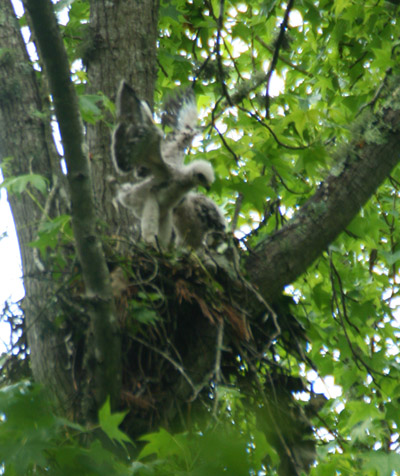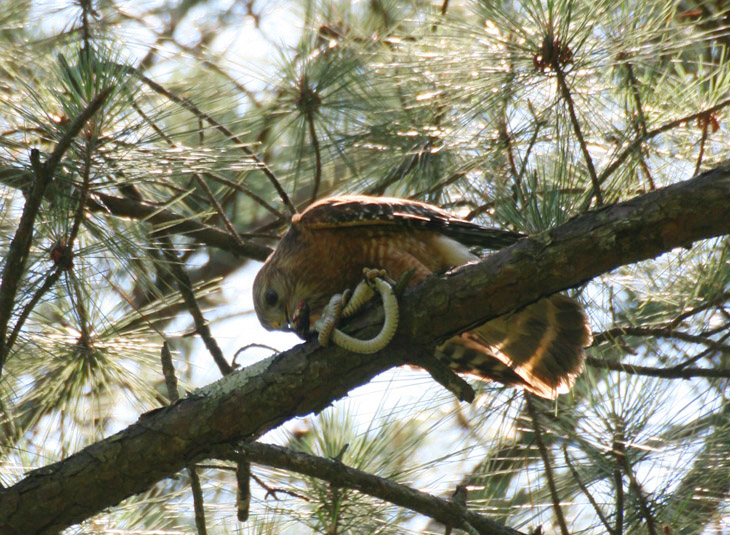While I’ve been keeping an eye on the progress of the red-shouldered hawk chicks, I’ve been having difficulty recording it due to a lack of free time concurrent with decent weather – we’ve had way too much rain for my liking. Yesterday I finally got it together, and the hawks were happy to oblige me.
 The chicks are getting quite sizable now, able to move about with almost the same agility as the adults and often seen standing upright near the edge of the nest. The baby down is giving way to the flight feathers in the wings and tail, but the main body feathers (called ‘coverts’) have yet to appear, which means the parents still hover over them on wet or chilly days. The body feathers are primary protection against the elements, forming both a water-resistant barrier and an outer layer that can trap their own body heat within; lacking these, they will rely on the parents for a while longer. Yet the growing surety of their movements and the alertness with which they view their surroundings is a marked change from just a week ago, not to mention that they’re surprisingly close to the adults in size now. I haven’t watched them for a long enough period to determine exactly how much they’re eating, but it certainly isn’t trivial.
The chicks are getting quite sizable now, able to move about with almost the same agility as the adults and often seen standing upright near the edge of the nest. The baby down is giving way to the flight feathers in the wings and tail, but the main body feathers (called ‘coverts’) have yet to appear, which means the parents still hover over them on wet or chilly days. The body feathers are primary protection against the elements, forming both a water-resistant barrier and an outer layer that can trap their own body heat within; lacking these, they will rely on the parents for a while longer. Yet the growing surety of their movements and the alertness with which they view their surroundings is a marked change from just a week ago, not to mention that they’re surprisingly close to the adults in size now. I haven’t watched them for a long enough period to determine exactly how much they’re eating, but it certainly isn’t trivial.

From the previous observation of their behavior, it appeared that the fledglings were starting to feed themselves, and they confirmed this during a shooting session yesterday morning. A parent appeared and dropped a small snake into the nest, not bothering to try and carve it up; to be honest, I’m not sure they even had the opportunity. Both younguns immediately seized it by either end and started a fierce tug-of-war that was delightful to watch. In the image above, the adult is to the left, one fledgling to the right, with the other just visible between them – the dark snake is easy to spot, but if you look close, you can see that the middle fledgling has a grip as well; the pale sharp curve of the lower beak can be made out just underneath the stretched body of the snake, right under the parent’s breast. I said it before: I would love to have a better view, but it’s not going to happen. I boosted ISO for this session to allow for a smaller, sharper aperture and a little better shutter speed, and the hit to image quality can be seen. This is almost full-resolution, a tight crop from the original frame.

While the beaks and talons are likely well-enough developed to chop up something as easy as a snake, the young have an instinct to gulp as much as they can before their sibling does, so biting through the snake would have worked against this. Instead, they simply tried swallowing everything they could while pulling it away from the other, and here I caught the back one in mid-gulp. But hey, I can do even better than this.
 When the action started I simply held the shutter release down and let the frames crank out. Later on, I took fourteen consecutive frames and edited them into this animated gif (pronounced “gorbachev”) because it shows the amusing struggle much better. Yes, video would be even better – drop me a donation through that ‘Feed the gator’ widget to the right and we’ll see what I can do. In the meantime, we’ll carry on with the still photos.
When the action started I simply held the shutter release down and let the frames crank out. Later on, I took fourteen consecutive frames and edited them into this animated gif (pronounced “gorbachev”) because it shows the amusing struggle much better. Yes, video would be even better – drop me a donation through that ‘Feed the gator’ widget to the right and we’ll see what I can do. In the meantime, we’ll carry on with the still photos.
(Has it occurred to you that if the snake had suddenly separated, at least one of them might have been flailing madly trying not to fall out of the nest? It certainly occurred to me.) Through it all, the parent simply watched impassively, probably ready to help out if the young still needed their meat cut up for them, but otherwise secure in the idea that they had little to do except provide. There’s no chance for an adult to play favorites now; the game is all about who grabs what first.
But the day wasn’t over yet. I was about to remark that the morning wasn’t even over yet, but looking at the timestamp on the next photos, I find that it was just barely after noon, so…
I had taken a break myself after the young polished off the small snake, but came back out to my post when the cries of the adults came rushing through the tree canopy. I was able to see both of them wheeling along the same flight paths, and vaguely suspected that I was seeing a territorial dispute with an interloper. However, the lead hawk alighted on a perch about half as distant to me as the nest, and within sight, too; moving the tripod by less than a meter afforded me a quite-clear view of the adult.

It’s obvious that the parent had yet another snake, this one markedly larger than the previous, and the hawk was intent on ensuring that the snake was dead – not at all surprising, since this one was big enough to make an escape if dropped live into the nest. From close examination of the photos I identify this as a black rat snake, and we pause briefly here for taxonomic trivia. Formerly known as Elaphe obsoleta (obsoleta,) the nomenclature has changed, but there isn’t a universal agreement on this yet. Overall, the species is now considered Pantherophis obsoletus, but there is some dispute over whether three separate regional species can be recognized; if so, that would likely make this Pantherophis alleghaniensis. Whatever – this particular one is hawk food any way you slice it.
The other adult seemed agitated by this whole behavior, perhaps because it disapproved of any dicking around that delayed food getting to the young, perhaps because it did not trust the other to deliver the food rather than keeping it for itself; I suspected this myself when I saw the hawk in possession avoiding the nest, as well as avoiding the other parent when they came crashing down on an adjoining perch. The second parent returned to the nest empty-taloned after the first flew off out of immediate sight, but this didn’t last long. Within another minute, the snake was delivered to the nest where the young had been watching the dance of the adults. And in fact, it took another close examination of my photos to ensure that the snake really had been brought in, since the young simply stared at it, perhaps too full to contemplate another bite right now, perhaps a little overwhelmed at the size which would prevent easily slamming it down; this one was going to have to be carved up first.

It’s safe to say that these fledglings are not suffering from neglect in the slightest, and also that the local snake population is being visibly reduced. That decline isn’t likely to drop off in the next couple of weeks as the young start flying and collecting their own meals, but it might eventually spread further out as they leave (or are driven from) the area to avoid competition. Before then, I’m hoping to capture a lot of images as they start to learn how to fly; once again, we’ll see what happens.




















































